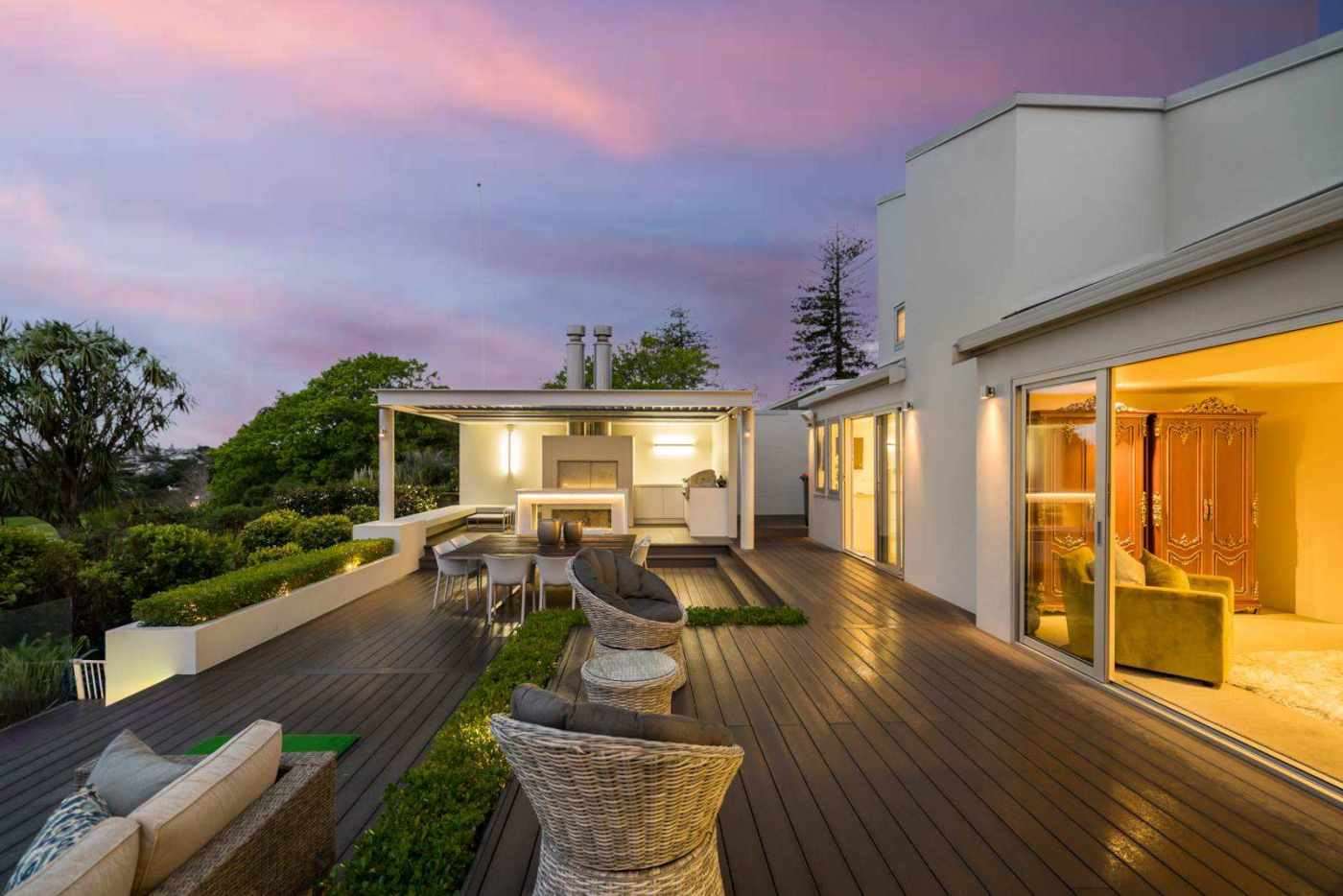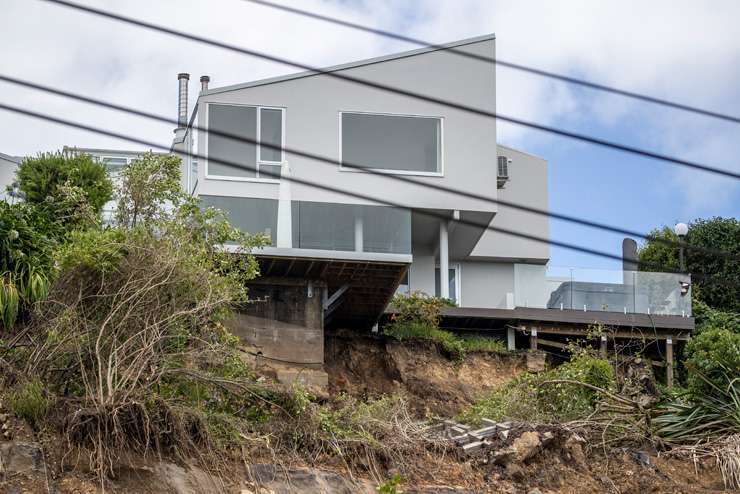Auckland’s floods have left homeowners in the city’s cliff-top locations feeling vulnerable and under pressure, experts have told OneRoof.
In Gary Wallace’s patch of Remuera and Parnell, many homes, some worth big money, have been hit with red and yellow stickers as a result of the recent extreme weather that claimed four lives and caused hundreds of millions of dollars' worth of damage.
The Bayleys Remuera agent highlighted the case of a Remuera property which he sold last year for around $11 million. The sale hasn't settled yet but now the “cliff is gone and they are hanging on by a thread”.
Wallace also sold a ground floor apartment in Parnell about seven or eight years ago, which had a magnificent harbour view, a patio and a beautiful garden, which he says now appears to be gone.
Start your property search
“You look at the photo, the slip is right back to the patio and all you can see in the photos are the piles that go down under the ground so it's just devastating.”
People are likely to think twice about buying cliff-top properties, he says, and this in turn could put pressure on other locations. “I think a lot of people now that would have just potentially gone and bought cliff-top now going to have a very serious think about it, no question.”
Read more:
- Remuera house is NZ’s third most expensive after $29m sale
- Flood damage: ‘If they try and hide it, they’re asking for trouble later on’
- Auckland flood damage: What are your legal rights?
Homes at the bottom of a cliff, on Remuera's Shore Road towards Parnell, have been the most high-profile property casualties of the flood so far. One house, at 33 Shore Road, tipped over in the January 31 floods, leaving a man dead. The house has since been demolished, and the properties either side are now no-go areas.
At the top of the cliff, teetering on the edge, sits a red-stickered home which had sold in November for more than $10m. Designed by 1970s architect Claude Megson and boasting dress-circle views of the city and the harbour, the property had been considered one of best on one of New Zealand's wealthiest streets.
Now questions surround its future. OneRoof understands the sale has not settled yet, although the agency that brokered the deal declined to comment on the sale or the property, which has a 2021 CV of $7.4m, of which $6.4m is for land that has suffered a huge slip and is now deemed a hazard.
The number of red-stickered homes in Auckland is barrelling close to 300. As of midday Wednesday, Auckland Emergency Management said 277 homes or buildings had been red-stickered, 1615 had been yellow-stickered and another 2566 homes or buildings had been white-stickered.

This luxury home on Arney Road sold for $10m-plus in November. It has since been given a red sticker. Photo / Supplied

The Arney Road property teeters over the edge. Photo / Hayden Woodward
Getting a coloured sticker or placard on your home does not mean it’s there forever but it can be the start of complex and time-consuming issues to overcome.
Red means the building cannot be entered because it is deemed unsafe and has sustained “moderate or heavy” damage and poses a significant risk to health or life. Yellow means access is restricted because the building may have received “sustained moderate damage” while white means the building has suffered light or no damage and can be accessed, although it does not necessarily mean the building is safe.
Engineering geologist Eleni Gkeli, who chairs the New Zealand Geotechnical Society, said that while it is technically possible that red-stickered properties could be remediated to become habitable again, the design and consent process could take years and the work cost hundreds of thousands of dollars.
She said that once a house has been stickered, the council brings in geo tech engineers, who make the assessment and recommendations on what needs to happen.
“It takes quite a few parties, it takes weeks. The system works, but I understand how frustrating it is for homeowners, it’s a huge inconvenience. People may be desperate to go home,” she said.
She added that neighbours of red or yellow-stickered houses should do their due diligence. “It costs less to be pro-active for a couple of thousand dollars than spend hundreds of thousands of dollars and have a lot of inconvenience and grief.”
Gkeli expects local authorities, central government and the public will need to re-examine how cities are planned in areas of risk. “It’s human nature to close your eyes to the risk, or you forget quickly,” she said.

REA chief executive Belinda Moffatt urges buyers and sellers impacted by the floods to seek legal advice. Photo / Supplied
In the 12 months to October 2022, consents were granted in Auckland for some 2223 dwellings located in hazard zones such as flood planes or erosion zones – 9% of the total consented. The raw figures do not show what, if any, remediation was required from builders in order to go ahead safely with new homes on hazardous sites.
At the start of this week, one of the country’s biggest insurance groups reported it had received more than 8000 claims, while a spokesperson from Toka Tu Ake EQC told OneRoof on Thursday that claims lodged with the agency exceeded 1500. The majority, 1155, were for slips.
Buyers and sellers in the city who are in the middle of settlement now face extra stresses.
Belinda Moffatt, chief executive of the Real Estate Authority, said all parties in the sale of an affected property should seek legal advice.
“A sale and purchase agreement usually has provisions on risk, pre-settlement damage and insurance. It is important that the parties discuss how these provisions will apply with a lawyer or conveyancer as soon as possible,” she said.
She said it may be possible for sellers who have already filed an EQC claim to transfer this claim to a buyer, but again, both parties should seek legal advice.

Ray White agent Ross Hawkins says affected properties will come out stronger as result of remedial work. Photo / Fiona Goodall
Buyers can also request EQC claim information from the agent selling the property, or request information directly from EQC to see if a claim was lodged on the property. Moffat said that buyers should speak with their own insurance provider about whether the property they wish to buy can be insured.
REA’s consumer website offers more help.
While sellers may hang on another week or so to let the market take a breath after the floods, Bayleys agent Wallace said he expects buyers will be active for some beautiful properties due to come to the market over the next few weeks.
Ray White agent Ross Hawkins is also upbeat. He said that while there are a few properties affected by slips around cliff tops, he is confident remedial work will result in better properties.
“Once the geo-tech experts and arborists have done the remedial work, there will be a lot more saleable property. Even if it takes some months, there’ll be a lot more market for them,” he said.
Hawkins says slips affecting cliff-top properties on top streets like Parnell’s Crescent Road or Judges Bay Road, Remuera or Orakei’s Paratai Drive are due to over-weight pohutukawa trees not being maintained.
“Look at every pile of dirt [from a slip] and there’s a pohutukawa tree. There’s just too much weight, they’re ripping out the bank when the ground is sodden. A lot of it is Auckland Council land. People have been on to them for years about these trees they have a responsibility to maintain.”
- Additional reporting by Catherine Masters


















































































